Weak bones, weak bladders
It’s World Osteoporosis Day soon (Oct 20), and while most of us are aware of the impact of osteoporosis on bone strength and height, its impact on urinary incontinence is not so well known.
There are some conditions where the link to incontinence seems logical, such as childbirth or obesity, but there are some where the connection is not quite so obvious.
One of these is the connection between osteoporosis and urinary incontinence. A 2009 Canadian study found that middle-aged and older women who suffered from osteoporosis had a much higher incidence of incontinence than women without osteoporosis.
Associate Professor Pauline Chiarelli, a physiotherapist and researcher at the University of Newcastle, provided her own evidence in support of the Canadian study when she presented her findings at last year’s National Conference on Incontinence.
Her findings were the result of her work as a research associate assisting with a 15-year Australian longitudinal women’s health study of more than 30,000 women by the University of Queensland and the University of Newcastle.
Dr Chiarelli said the link between height loss associated with curvature of spine and incontinence was now the subject of current research.
She said that, while it was well understood that women with osteoporosis lost height because of the curvature of the spine associated with vertebral fractures (the most common osteopathic female fracture), there was now a body of evidence suggesting that curvature of the spine increased the risk of pelvic organ prolapse as the result of the subsequent altered positioning of the organs, muscles and bones within the abdominal cavity.
This lends support to the hypothesis that the altered forces pushing on the bladder as a result of the spinal deformity might be implicated in incontinence, Dr Chiarelli said.
Osteoporosis occurs predominantly in women aged 55 and over, with 1.2 million Australians estimated to have the condition. Osteoporosis Australia advocates three main measures for the prevention of osteoporosis: adequate calcium intake, normal vitamin D levels (to help absorb calcium) and specific exercises.
According to the Australian Government dietary recommendations, the recommended intake of calcium for women after the age of 50 increases from 1000mg a day to 1300mg.
The need for vitamin D also increases beyond the age of 50, and then again beyond the age of 70. Australian Government recommendations of vitamin D are the subject of much debate among the medical community, ranging from as low as about 400 international units (IU) a day to up to 3000IU a day.
The third component of osteoporosis prevention – exercise, and in particular including weight-bearing and resistance exercise – was problematic for some women who experienced leakage during physical activity Dr Chiarelli said.
She directed them to the www.pelvicfloorfirst.org.au to learn the correct technique for pelvic floor exercises and for adapting regular exercises to be safer for the pelvic floor.
In Dr Chiarelli’s view, women who are diagnosed with osteoporosis need to be screened for, and informed about, their increased risk of urinary incontinence and pelvic organ prolapse.
“Currently, an average of one osteopathic fracture takes place in Australia every eight minutes, and this is expected to more than double in seven years’ time if the trend continues,” Dr Chiarelli said.
“Osteoporosis is life changing, debilitating, painful and associated with high morbidity and some mortality, but it’s very common and very preventable.”
For help with incontinence go to www.continence.org.au or phone the National Continence Helpline (1800 33 00 66), which is staffed by continence nurse advisors who provide advice, referrals and resources to consumers and health professionals.
Fast facts*
- In 2010, nearly 4.8 million Australians – comprising more than a quarter of the Australian population aged 15 years or over – were living with incontinence.
- By 2030 the prevalence is estimated to increase to 6.5 million Australians (with urinary incontinence, faecal incontinence or both) – equating to 27 per cent of the population aged 15 years and above.
- Incontinence affects both men and women – regardless of their age, gender or cultural background.
- Women are more likely to be incontinent than men – with the life stages of pregnancy and menopause a major contributing factor.
- One in three women who have ever had a baby will wet themselves.
- Despite common belief, over half of the women living in the community with incontinence are under 50 years of age (1.7 million).
- Incontinence is more prevalent than asthma (more than 2 million), anxiety disorders (2.3 million) and arthritis (3.1 million).
- In 2010, the total financial cost of incontinence was estimated to be $42.9 billion – or $66.7 billion including the cost of burden of disease.
- In 2010, the total productivity loss due to incontinence was $34.1 billion.
- In 2010, the opportunity cost of informal (unpaid) care provided by loved ones to those with incontinence was estimated to be $2.7 billion.
* Information based on Deloitte Access Economics The economic impact of incontinence in Australia 2011, commissioned by the Continence Foundation of Australia. For the full report go to www.continence.org.au
(Source: Continence Foundation of Australia)
Dates
Tags
Created by:

 Login
Login














